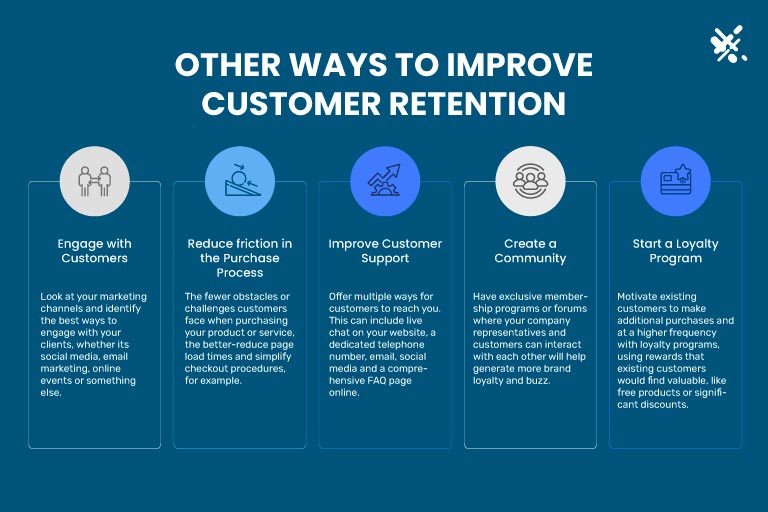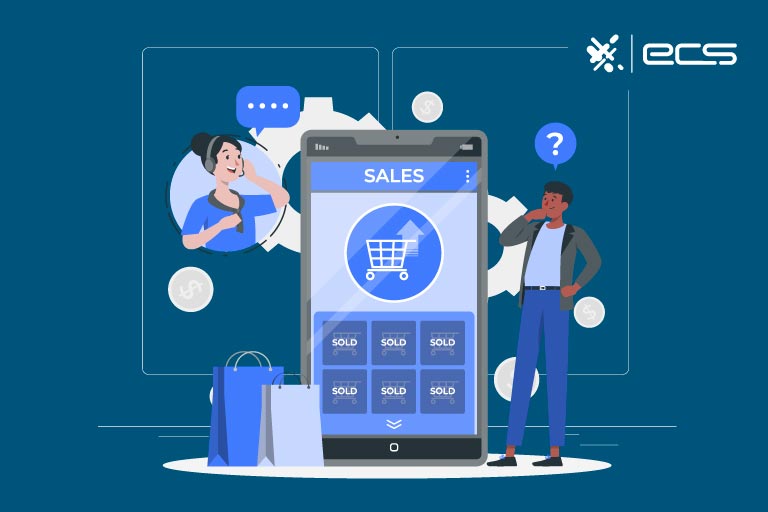“If you build it, they will come.” The prophetic utterance of James Earl Jones in Field of Dreams may be true about baseball-playing ghosts. But it’s definitely not true instruction for how to drive sales to your website.
For that, you’ll need to mix some marketing with a little bit of graphic design and sprinkle some psychology on top. But what exactly does that cooking analogy mean, anyway? Let’s take a deeper look at how to drive customers to your website.
How Do Brick-and-Mortar Businesses Drive Sales?
“If it ain’t broke, don’t fix it,” the popular adage goes. Brick-and-mortar businesses have been thriving off the same marketing strategies for thousands of years, which actually—as it turns out—actually does involve a heavy dose of “if you build it, they will come.”
Brick-and-mortar retailers have been able to rely on the natural influx of customers from foot traffic. Which means that half the battle is picking out the right shopping mall (here’s a hint: good parking always helps).
Making the interior of a store look pleasing also goes a long way. Around 66% of consumers will walk out of a store because of dirty restrooms, 60% because of a dirty entryway, and 56% because the dressing rooms are disorganized. The good news for online business owners is that these are not problems you need to worry about. Or are they?
As we’ll see, the principles behind store organization also do apply to websites—but more on that later. A clean store with strong product displays can turn window shoppers into actual shoppers, for both online and brick-and-mortar businesses.
Then there are the people running the store. As many as 68% of customers will walk out of a store because they are treated poorly (although that may be subjective). Good customer service often involves standardizing the look of your employees, as well as their patterns of interaction, such as the language they use when talking to customers.
Come to think of it, this is probably why robots and AI may eventually supplant human customer service. A study by Durham University Business School found that 60% of hotel customers dealing with a robot concierge felt joy (it gets weirder), 28% felt fear, and 20% felt love (we’ve arrived at weird).
Drive Sales With Location, Appearance, and Customer Service
In any case (lest we start digressing into a sci-fi love story) brick-and-mortar stores have traditionally relied on location, appearance, and customer service to build a stream of sales traffic and ongoing customer loyalty. The most successful businesses will become corporate chains or franchises, leveraging a look that for whatever reason captivates consumers.
Interestingly, one of the most successful models of brick-and-mortar sales growth has involved clowns, a purple thing, and an aggravating red and yellow color scheme (we’re talking about the world’s largest food retail chain here, affectionately known as Mickey Dees).
But does any of this have anything to do with an online business? As we’ve briefly mentioned, yes, yes, and yes. But before we go into drawing parallels, let’s look at a more recent trend in sales development that is also crucial for driving sales.
Advertising Drives Sales
The world’s first advertisement was found in Egypt and dated to about 3,000 BC. It was a papyrus advertisement put out by an owner looking for a runaway slave, who was also promoting his weaving shop (talk about a bizarre mashup).
Fast forward to the beginning of the 18th century, when the first newspaper advertisements were circulated. Then in the 18th century, billboards appeared. This indirect marketing was all the rage until Sears started sending catalogs to customers in 1892.
The success of one marketing campaign where Sears mailed out 8,000 postcards and generated 2,000 sales inspired other companies to dabble in direct marketing—something you can still enjoy today when local restaurants leave menus on your doormat.
How Did Technology Change Advertising?
Radio and television created new marketing opportunities through commercials. This led to the introduction of characters that consumers would associate with a product—for example, Ronald McDonald, Hamburgler, and the purple thing they hang out with.
Commercials eventually became more than advertisements: they’ve become part of larger narratives that permeate our cultural consciousness. From a psychological perspective, the sense of positive camaraderie generated by these characters invites customers to shop or dine with that brand.
The internet further changed the marketing game. Companies like Yahoo and Google created unique advertising models where companies could pay per click instead of dumping money into a billboard and not knowing how many consumers it actually impacted. They could also tailor their ads to certain demographics or connect them to certain search queries.
This is where the state of advertising stands today: digital and print media. And in terms of driving traffic to your site, it’s just one of many ways to increase website traffic, attract new customers, and increase online sales. Let’s first take a look at one of the more recent but still strong trends in driving more sales to a website, which is content marketing.
Drive Sales to Your Website With Content Marketing
Content marketing is all about creating blog posts and videos for a target audience, in the interest of creating a customer base and building trust. The target audience is anyone who could benefit from a good or service offered by your business.
Ideally, this customer would type something into a search engine (like how to drive traffic to your website) and get a post like this. Or maybe they would search for how to fill out a 1040 on their tax return and decide to hire your accounting firm. Or maybe they’ll search for how to replace a car transmission, give up, and call your mechanic shop.
That’s the idea of blogging for business: you hook the reader by providing them with some content that relates to your business and their needs. When they need you (maybe immediately), they’ll reach out for help. The more value an article can bring to its reader, the higher up the organic search rankings it will move, giving that business more exposure.
Businesses can do research for trending topics within their industry by a simple Google Analytics search and begin writing articles from that result. And if you aren’t the greatest writer, don’t have a writer on your staff, or have tired out your writers, you can always invest in guest postings.

Drive Sales to Your Website With Promotions
Content marketing might also involve providing potential clients with a free eBook or course about a topic related to your business that also interests them. Of course, you don’t want to give away everything in this content, otherwise, they won’t need your help.
This concern is primarily for service-based businesses, which might lead you to wonder if goods-based businesses can deliver content marketing (they can, and more on that soon). To receive this content, the customer will need to provide their email address. You can then use that to start sending them more content, as part of something called the sales funnel.
Content marketing for goods-based businesses is also a good idea. Every Disney show or movie you’ve ever seen is a piece of animated content marketing for the billions of dollars of merchandise licensing they take in. And it can certainly work for a small business: for example, if your business sells barbecue sauce, you could write articles about recipes or make cooking demo videos. A customer might search for how to make brisket properly, read a salivating article written by you, and then order some barbecue sauce.
Drive Sales to Your Website With Sales Funnels
You’ve probably heard the term sales funnel before. And while funnel is a word that has a much nicer ring when paired with cake, sales funnels can drive a significant amount of customers to a website or landing page.
One study found that companies who nurture their leads generate 50% more sales-ready engagements at 33% of the cost. While much ink has been spilled on the psychology of the sales funnel and which models are the best, in general, they are composed of a few stages: awareness, interest, desire, and action.
To return to our earlier content marketing example for barbecue sauce, a customer will search for a brisket recipe. At this point, they’re not even thinking about buying barbecue sauce, but this article makes them (1) aware of your business. After reading the article, they develop (2) an interest in getting a free recipe book, for which they provide their email. It may take a few weeks of reading a daily email recipe, but eventually, they start to (3) desire your barbecue sauce because it’s in every recipe you’re sending them—go figure. One day they can hold out no longer and (4) take action by ordering an entire pallet.
In terms of tying this example to other examples of driving traffic to a website, let’s incorporate something called social proof. Because they’ve seen that your barbecue sauce is getting such rave reviews, they’re willing to order more of it, sight unseen (or tasted, perhaps). And where did they see all these stellar reviews? On social media.

Drive Sales to Your Website With Social Media Marketing
One form of social media marketing goes back to traditional paid advertising, so more on that later. For now, let’s focus on the other aspect of social media marketing, which is social proof.
The average millennial has between 8 and 9 social media accounts, although this number ranges from country to country—it’s typically 3 in Japan, and 12 in India (what else can you expect from the land with 121 languages). And the average person is spending 2.5 hours per day scrolling, posting, commenting, and maybe stalking a crush.
When social media users come across other people using your product, that builds a type of trust called social proof. It’s the same type of trust they would get from seeing positive customer reviews, which is essentially what these posts are all about. Pictures and especially videos of real people using your product are one of the strongest marketing tools you can leverage today, using a sort of herd mentality.
One way to build the herd is to develop digital branding around your product. Put a call to action in your product packaging for customers to post their experience on social media and use your branded hashtag. Over time, you will have organically grown a huge following of customers who are generating massive exposure to whatever you’re selling, which in turn can lead users to your product page and website.
Drive Sales to Your Website With Influencer Marketing
But there’s more to it than just developing a herd. One of the biggest types of social media marketing these days is influencer marketing. This involves sending your product to popular people or providing them with your service. For instance, if you own a Bed and Breakfast, you might ask a popular Instagrammer to stay there and document their trip, giving your property exposure to all their followers.
Or if you own a barbecue sauce company (we just can’t get away from that tangy combination of sweet and spicy), you could give your product to a chef. Next time they use your sauce in one of their videos, all their followers will be exposed to it. And not only that, they’ll trust the product because someone they trust trusts it too.
Drive Sales to Your Website With Traditional Advertising
Traditional advertising is not dead and it’s still one of the best ways to get sales. In fact, social media has made traditional advertising even more accessible for the average business and even more effective.
That’s because these tech companies have collected huge (creepy huge) amounts of very nuanced data about everyone. Which they can use to facilitate targeted marketing. They can also sell this data to foreign governments, but that’s a rabbit hole for another day.
For example, just about $7 to $10 per day on a platform like Instagram will allow you to put an ad for your barbecue sauce in front of about 4,000 people in Texas between the ages of 18 and 44 who enjoy cooking, grilling, and taking pictures of food. Yes, that’s right—you can target ads by location, gender, age, and interests.
Instagram knows what their interests are because they’re posting about it all the time. In any case, this sure beats paying $10,000 for a billboard and then hoping at least 3% of the people who drive in front of it will remember your barbecue sauce the next time they’re at the grocery store.

Customer Retention is the Most Valuable Form of Marketing
It may sound ironic, but one of the best ways to drive more sales to your website is to not have to hunt for new customers (or have them hunt for you). It’s to turn customers you already have into repeat customers. And a large part of that depends on user experience.
At the outset of this article, we mentioned that brick-and-mortar businesses have traditionally relied on location, appearance, and customer service to drive sales—and that these ideas had parallels in the realm of digital marketing.
Location and Investment Advertising
Location is one we have covered already, in that your investment in social proof, content marketing and search engine rankings, and even paid advertising is sort of like the money you’d invest for a better spot at the mall. Think of these things like the rent you’re paying for a retail pad next to the mall’s busiest area.
Cleanliness and Customer Service
But what about cleanliness and customer service? These concerns have parallels in the appearance and functionality of your website. While there may not be half-smoked cigarettes and empty beer bottles by the doorway, or a stuffed-up toilet in the back, there are websites that haven’t had a facelift since the 1990s.
And in terms of customer service, there is the checkout process itself. Some of the most common reasons for abandoned carts include surprise costs (55%), a requirement for an account (34%), and a lengthy checkout (26%).
A beautiful website that’s easy to navigate and a smooth checkout process will go a long way toward bringing business back to your website, as will some post-purchase TLC. For instance, a follow-up email requesting a review not only gives you an opportunity to build up some valuable social proof—it also shows your customer that you care.
Considering that the probability of closing a sale with a new customer does not exceed 20% and that closing a sale with a previous customer has a likelihood of at least 60%, it makes sense to drive more sales to your website by focusing on family (and by family, we mean customers, not necessarily those who dine at Olive Garden).
Drive Sales to Your Website With Paper Mailing
One last suggestion for how to drive more sales to your online store may seem a little bit off the wall: paper. And not just any paper, but paper that you send to customers. Although it’s a far cry from 1892, the strategy employed by Sears is perhaps even more valuable in an era where social media (in large part) has lowered consumer attention spans to beneath that of a goldfish (you read that right).
Paper mailings do not have to fight against the next video or post. That’s probably why direct mail has a higher ROI (29% median) than paid search ads (23%). If you’re shipping an item to customers, use that address to drive customers to your business. Namely, customers you already have.

Conclusion
In summary, getting more visitors to your website is a battle with several fronts, search engines, social media, the mailbox, and the website itself. Which is perhaps the most important battlefront for getting return customers. But if you strategize, invest wisely, and retain any information from your reading today, you should be seeing those click rates begin to spike.
To contact sales, click HERE. And to learn more about ECS Payment Processing visit Online Payments.
